Stunning Angkor Wat Temples
- Fiona
- Apr 24, 2020
- 7 min read
Updated: Jul 2, 2020
The Angkor Archaeological Park covers approximately 400 square kilometres, including forested area, and it contains the spectacular remains of several capitals of the Khmer Empire from the 9th to the 15th centuries. The most famous, are the temples of Angkor Wat and the Bayon temple at Angkor Thom. We visited these two temples as well as the unusual temple complex at Ta Phrom.
Although only approximately two kilometres apart in physical distance Angkor Wat and Angkor Thom were both capital cities of the Khmer Empire. They were built at different times - Angkor Wat at the beginning of the 12th century; and Angkor Thom at the end of the 12th century into the early 13th century.
Angkor Wat was originally built as a Hindu temple by a Hindu king but became a Buddhist temple by the end of the 12th century.
Angkor Thom was built under a Buddhist King, King Jayavarman VII, who also saw the conversion of many of the other Hindu Angkor temples (including Angkor Wat) into Buddhist temples.
Ta Phrom is located outside the walls of Angkor Thom. It is famous because it has been kept in a similar ruinous condition to how it was when it was rediscovered in the late 19th century.
On the day that we explored these three temples, Mr Han, our tuktuk driver, picked us up from our hotel at 7am on a chilly morning and we made our way to the first stop - Ta Phrom. From there we went to the Bayon temple in Angkor Thom and we finished the day at the Angkor Wat .
Ta Phrom
The construction of Ta Phrom occurred largely in the late12th and early 13th centuries. It was built as a Mahayana Buddhist monastery and university. The following extract gives some idea of the size of the temple complex...
"Ta Prohm was home to more than 12,500 people, including 18 high priests and 615
dancers. More than 800,000 people living in surrounding villages provided services and
supplies to the temple, which was home to a bounty of treasures that took in gold, pearls and
silks."
In the 15th century the Siamese attacked the Angkor kingdom and the temples were abandoned as the Khmer elite relocated to Phnom Penh. The temples were forgotten and nature was left to take its course for several centuries until the Angkor temples were rediscovered in 1860 by Henri Mouhot.
Ta Phrom temple is composed of towers, closed courtyards and narrow corridors and these days, it has a reputation for being the most atmospheric of the Angkor temples. The silk-cotton, the thitpok and banyan trees spread their gigantic roots over stones, pushing walls and terraces apart. The tree branches and leaves now intertwine to form a roof over the structures, filtering the sunlight and casting a greenish pall over everything; added to this is the lichen and moss that cover the external walls and deepen the viridescent light.
Restoration of the temples in the Angkor Archaeological Park (including Ta Phrom) began in the early 21st century, under the direction of the French. Experts decided to leave the enchanting, root-entangled temple as it was – swallowed by the jungle.
However, when I compare it to what it was like when I visited in 2004 - I thought that the restoration work had lessened its enchantment. There are now wooden walkways and hand rails installed and the jungle has been pruned back to protect the crumbling ruins Although this restoration diminishes the atmosphere at Ta Phrom it would seem necessary to protect and preserve this amazing ruin.
We visited Ta Phrom in the early morning when there were very few tourists (most go to Angkor Wat first) and so it was peaceful, quiet and rather beautiful. The red soil and blocks of the walls that we saw as we entered the temple complex were a marvellous contrast to the green of the jungle canopy and the lichen and moss on the buildings. The merging of the tree roots and the ancient stones were an extraordinary sight.
1. Setting off in our tuktuk with Mr Han our driver.
2. As we arrived at Ta Phrom we were greeted by our first hawker of the day - sadly the hawker was this gorgeous little girl. She wanted us to buy her fridge magnets.
3 - 4 - The crumbling outside wall of Ta Phrom
Below is a selection of images from inside Ta Phrom showing
the beautiful carvings
a woman selling blessings for a happy life
a restoration team
the amazing trees and tree roots growing out of the buildings
the moss and lichen covered ruins
Angkor Thom and the Bayon temple
We cruised past the Terrace of Elephants in our tuktuk on the way to see the Bayon temple in Angkor Thom. The Terrace of Elephants is part of the walled city of Angkor Thom. It is a 350 metre long terrace that was used as a giant viewing stand for public ceremonies and it also served as a base for the king's grand audience hall.
Angkor Thom was the last and most enduring capital city of the Khmer kingdoms. It was a walled city state, the Bayon temple is in the centre of the city and there are four very impressive gateways into the city that are built in the same captivating style as the Bayon temple.
The Bayon temple is an impressive buddhist shrine with over 200 smiling faces carved into 54 gigantic stone towers. Most of the towers have four faces, some have only two or three, while the central tower has many more. The faces are supposedly of Buddha but apparently they also look like the founder of the complex King Jayavarman VII. The temple has three levels; the first and second levels have square galleries featuring bas-reliefs. A circular central sanctuary dominates the third level. Within each of these levels there are the galleries and maze-like narrow passages with low ceilings and steps.
The bas-relief carvings in the galleries are well-preserved; the internal gallery shows Brahmanic mythological subjects and the outer gallery is dedicated both to scenes of everyday life and to certain historic episodes - processions and battles from the reign of Jayavarman VII.
It was amazing to wander around this temple - there were so many photo opportunities. I particularly liked all the door ways, the buddhas, and of course the towers with the faces - it was incredible to think about how it was made over 700 years ago. There were real dancers in traditional costumes at the temple (for the tourists we thought) and their colourful clothing contrasted beautifully with the ancient stones.
Angkor Wat
It was midday by the time that we arrived at the Angkor Wat and it was so hot. I think even the photos show the heat haze! We had to walk across an exposed floating bridge (while the stone walkway was being restored) to get to the entry of the temple complex - it was a relief to get inside and out of the sun.
Why it was built
The Angkor Wat was originally built in the first half of the 12th century as a Hindu temple and it is said to be the largest religious monument in the world. It was built in the reign of King Suryavarman II and was originally dedicated to the Hindu god Vishnu, but it became a Buddhist temple by the end of the 12th century.
and why it was abandoned...
One explanation for the collapse of the Angkor civilisation was that in 1431 it was abandoned following the Thai Kingdom of Ayutthaya's sacking of the then capital city of Angkor - the city was subsequently abandoned by the Khmer people as they fled south to Phnom Penh. This idea that the Angkor capital was abandoned also supported the romantic19th century colonial interpretation of Angkor as a civilisation forgotten by the Cambodians and left to decay in the jungle.
An alternative view that archaeological evidence shows is that the decline of the Angkor civilisation was a long and complex process explained by a religious shift which disrupted the pre-existing Hindu-based power structures. State-sponsored stone temples and royal bureaucracy changed to community-based Buddhist pagodas, built from wood. At the same time, maritime trade with China was increasing and so the relocation of the capital further south closer to waterways and near the modern capital of Phnom Penh, allowed rulers to take advantage of these economic opportunities.
Also, region-wide environmental changes were taking place at the time including a series of decades-long droughts, interspersed with heavy monsoons which destroyed Angkor's famous system of reservoirs and water channels and signalled the end of the city as a settlement.
Other things we wondered about when we wandered through the complex...
1. Why are the buddhas headless?
The headless buddhas intrigued me...I discovered that since its rediscovery in the late19th century the site has suffered from decades of unregulated tourism and looting; many ancient statues have been decapitated and their heads sold to private collectors. Cambodia's recent violent history provided an almost ideal opportunity for plundering. The Communist Khmer Rouge destroyed many of the temples and written records, while the occupying Vietnamese Army which followed, well aware of the value of Angkor art in the West, removed pieces by the truckload. Even more damage was done after the wars, by art thieves working out of Thailand.
The Angkor archaeological park was declared a UNESCO World Heritage site in 1992 - this accreditation means that UNESCO organises the mobilising of international co-operation for the protection, preservation and presentation of the site which thankfully has also reduced the looting.
2. There were a lot of people there - despite the fact that tourism numbers were low for this time of the year (the beginning of the Covid-19 pandemic meant there were no Chinese tourists). The mind boggles at what it wold be like during a normal peak tourist time.
3. The procession of people going up to the second level of the tower. When I was there in the early two thousands I (along with all the other tourists) was able to climb the actual stone staircase. It was dangerous and rather scary and so it was good to see the stairs there now - from both a preservation and a safety aspect.
4. We came across a monk blessing ceremony - where the monk sprinkled water on the pilgrim while chanting and after saying some words for a happy life he tied a red string around the pilgrim's wrist - a band that must stay until it naturally falls off.
The offering of holy water symbolises the cultivation of the virtues of calmness, clarity, and purity of our body, speech, and mind. Cambodians believe that the holy water is the water that can take away your bad luck, weak soul, and bring back good things.




















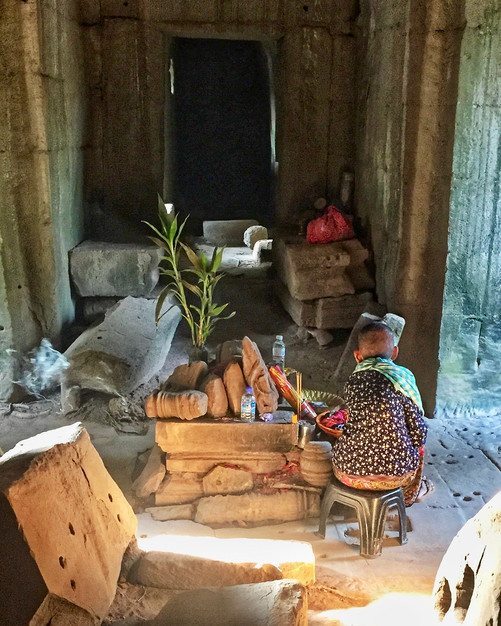







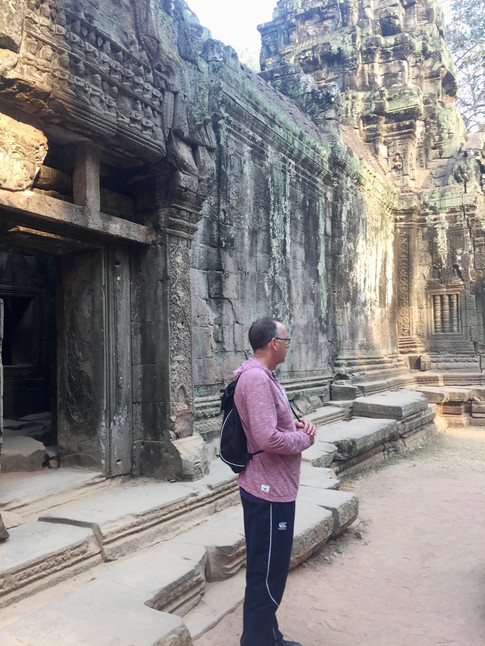



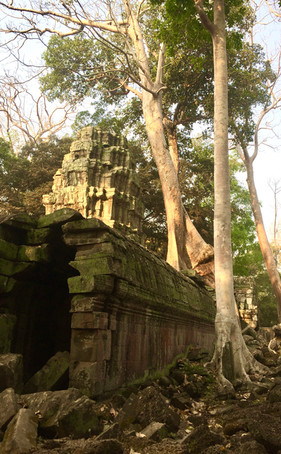











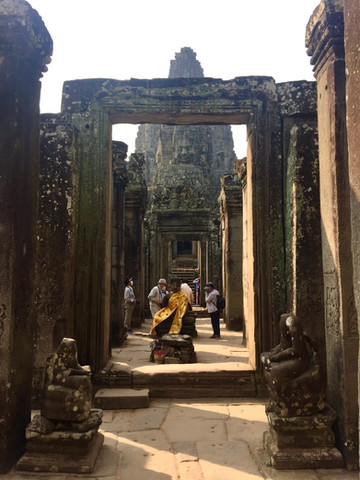











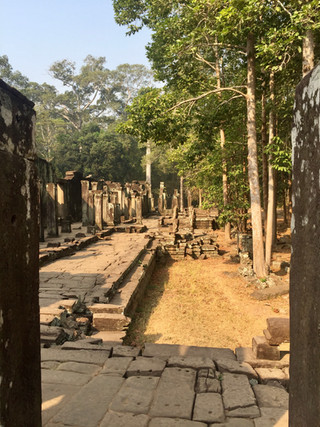





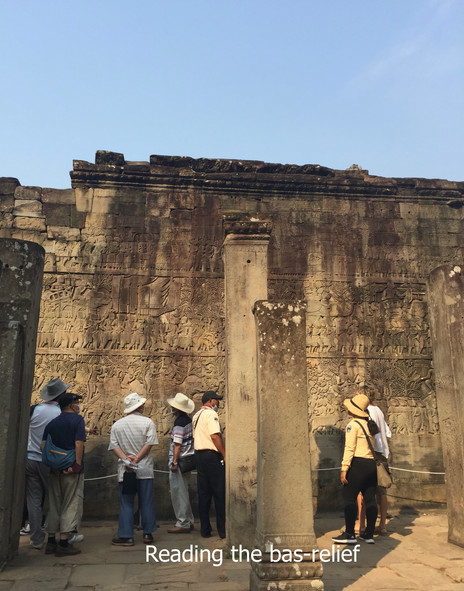



















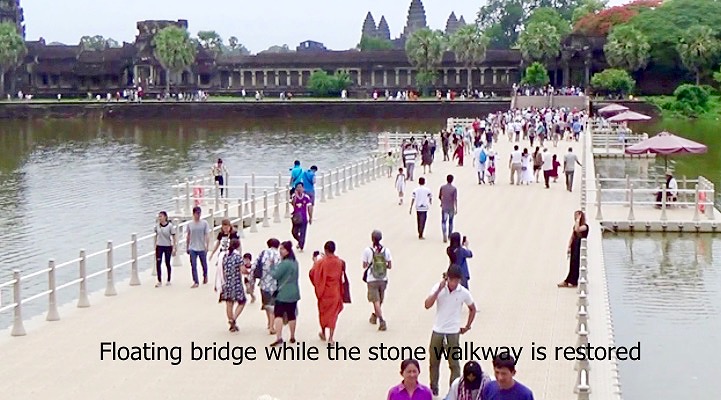



































Comments